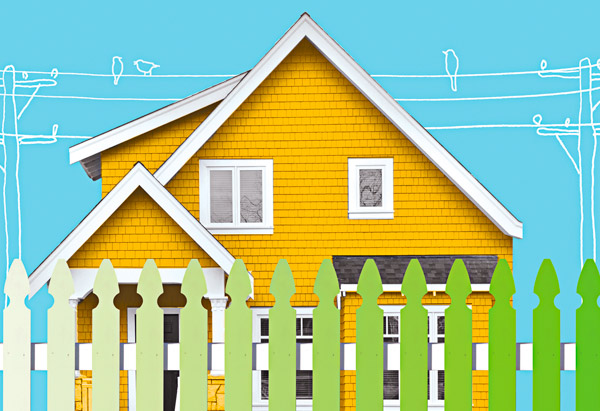A Step-by-Step Guide to Curbing Your Energy Costs
If gas and electric costs are leaving you cold, you can seal up drafts, add insulation—or even move into a futuristic heat-harnessing home.

Illustration by David Drummond
A $250 heating bill. A $300 air-conditioning bill. The costs add up. And while you wouldn't leave a window open year-round, your house may be doing the equivalent for you, if it's riddled with drafty air ducts, insulation gaps, and leaky seams. To cut costs and do their small part for the planet, some families are moving into "passive houses," which use roughly one-fifth the energy of a regular home and slash heating costs by as much as 90 percent.
Passive homes are virtually airtight, extraordinarily well-insulated buildings that harvest heat generated inside the house—and keep it there. Materials like concrete and granite act as thermal storage units, soaking up heat from household electronics and even residents' bodies. Specially treated windows capture more sunlight. (In warmer climates, reflective windows are installed to keep the home from feeling like an oven.) Constant air exchange between indoors and outdoors keeps things from getting stale, and, yes, you can open the windows.
Passive certification is one of the world's most stringent standards for energy-efficient construction. These principles were actually developed in the United States and Canada in the mid-1970s but didn't catch on because energy prices here were so low at the time, there wasn't enough incentive to invest. Not so in Germany, where, in the '90s, engineers and architects embraced the concept and refined and strengthened the standards. More than 30,000 passive buildings have since been constructed in Europe (called Passivhaus there). Now passive design is swinging back Stateside: Dozens of residential and commercial projects are in the works from Oregon to North Carolina, and by the end of the year, 200 American families could be living in passive homes.
"If you can be comfortable by passive means, rather than actively burning fossil fuel, that's ideal," says Katrin Klingenberg, executive director of Passive House Institute U.S., which grants certification. "A building that is almost self-sufficient is a beautiful thing." She also points out that the higher up-front costs (up to 15 percent for new buildings) pay off handsomely in the long run.
Next: From basic to advanced, three ways to save on energy costs at home
Passive homes are virtually airtight, extraordinarily well-insulated buildings that harvest heat generated inside the house—and keep it there. Materials like concrete and granite act as thermal storage units, soaking up heat from household electronics and even residents' bodies. Specially treated windows capture more sunlight. (In warmer climates, reflective windows are installed to keep the home from feeling like an oven.) Constant air exchange between indoors and outdoors keeps things from getting stale, and, yes, you can open the windows.
Passive certification is one of the world's most stringent standards for energy-efficient construction. These principles were actually developed in the United States and Canada in the mid-1970s but didn't catch on because energy prices here were so low at the time, there wasn't enough incentive to invest. Not so in Germany, where, in the '90s, engineers and architects embraced the concept and refined and strengthened the standards. More than 30,000 passive buildings have since been constructed in Europe (called Passivhaus there). Now passive design is swinging back Stateside: Dozens of residential and commercial projects are in the works from Oregon to North Carolina, and by the end of the year, 200 American families could be living in passive homes.
"If you can be comfortable by passive means, rather than actively burning fossil fuel, that's ideal," says Katrin Klingenberg, executive director of Passive House Institute U.S., which grants certification. "A building that is almost self-sufficient is a beautiful thing." She also points out that the higher up-front costs (up to 15 percent for new buildings) pay off handsomely in the long run.
Next: From basic to advanced, three ways to save on energy costs at home



